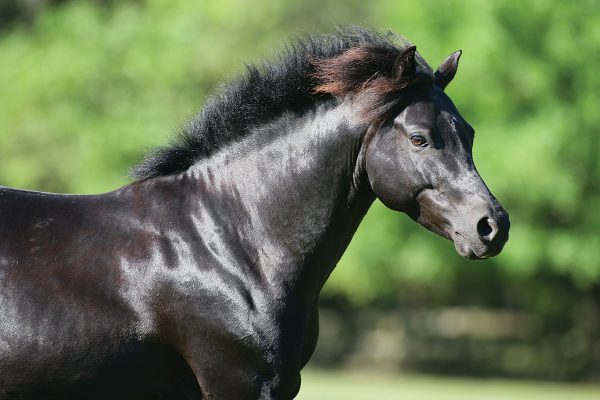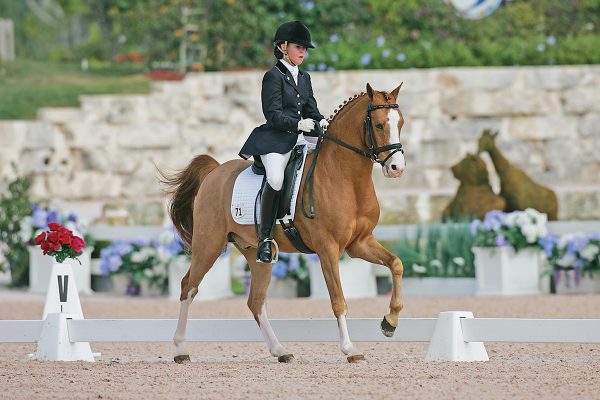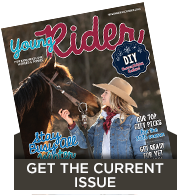If you’ve been around horses for a while, you probably know all about popular breeds like Thoroughbreds and Arabians, and maybe even some lesser-known breeds, like Akhal-Tekes and American Cream Drafts. But have you heard of the Deutsches Reitpony? Actually, you probably have—the Deutsches Reitpony is the name of the breed in Germany, but here in America, it’s known as the German Riding Pony.

Filling a Need
Back in the mid-20th century, riders in Germany saw the need for a new breed that would possess the athleticism and versatility of warmbloods, but in a smaller size to suit youth riders. Essentially, they wanted to replicate what everyone loved about warmbloods, but in a pony-sized package.
Sounds easy, right? Just choose an assortment of foundation horses and ponies until you get the desired type and size. But it wasn’t quite that easy.
Achieving the desired quality and height meant that horse and pony breeds had to be carefully selected, and the best results didn’t happen overnight. Breeders experimented with many different breeds, but ultimately found that British native ponies, like Welsh and New Forest, were helpful in development of the desired German Riding Pony characteristics.
By the mid-1970s, the idea of a Deutsches Reitpony had become a reality. It proved to be beautiful and versatile, and had all the characteristics needed to shine in the show ring—especially in dressage, but also in jumping and eventing.
Outside breeds are still used in the breeding of German Riding Ponies, even today. Individual animals are selectively chosen and must display the characteristics that make the German Riding Pony so beloved.
Some of the outside breeds that can be used to produce German Riding Ponies include various warmblood breeds, Arabians, Anglo-Arabians, New Forest Ponies, Connemara Ponies, and all four sections of Welsh Ponies (especially Section B) and Cobs, but many others can also be used.
Designed for Dressage
The German Riding Pony’s high standards for quality, trainability, and type make it extremely well-suited to dressage, and dressage is by far the most popular discipline for this breed in the United States. The vast majority of German Riding Pony breeders in America have dressage in mind for their ponies.

But that’s not to say that German Riding Ponies can’t succeed in other disciplines—they absolutely can! You’ll find them competing in hunters, jumpers, eventing and driving. You’ll even find them at Pony Finals.
How are these top-quality ponies consistently produced? The inspection and licensing process is an important piece of the puzzle. Inspections are held all throughout North America. The inspection process helps to ensure that the ideal German Riding Pony type is present and that all ponies meet the standard. Performance testing of older ponies is another element that helps keep the standards high.
When it comes to registering German Riding Ponies in the United States, there are a few options. Some people choose Weser-Ems, which works with the Oldenburg Horse Breeder’s Society; others register with the Westfalen Verband North America. Some German Riding Ponies are registered with one of the North American sport pony registries.
German Riding Pony Fast Facts
◆ The ideal size for German Riding Ponies is 13.2 to 14.2 hands (for international sport, to have fun, or to complete in other events, the ponies can be bigger).
◆ Bay, black, chestnut, gray and palomino are common colors for the breed.
◆ The legendary stallion Dornik B reached Prix St. Georges level in dressage. Dornik B is well-remembered for winning multiple gold medals at the European Pony Championships.
◆ A Weser-Ems German Riding Pony named Konrad had a hugely successful career as an FEI dressage pony, winning eight gold medals at the European Pony Championships.
◆ The Westfalen Verband North America and Pferdestammbuch Weser-Ems describe the German Riding Pony as athletic, elegant, and versatile, and they note that its willingness and character are of “exceptional quality.”
If you love the idea of a warmblood in a pony package or dream of competing in dressage, then a German Riding Pony just might be right for you!
To learn more about these athletic and trainable ponies, visit pferdestammbuch.com or westfalenverband.com.
This article appeared in the July/August 2024 issue of Young Rider magazine. Click here to subscribe!


